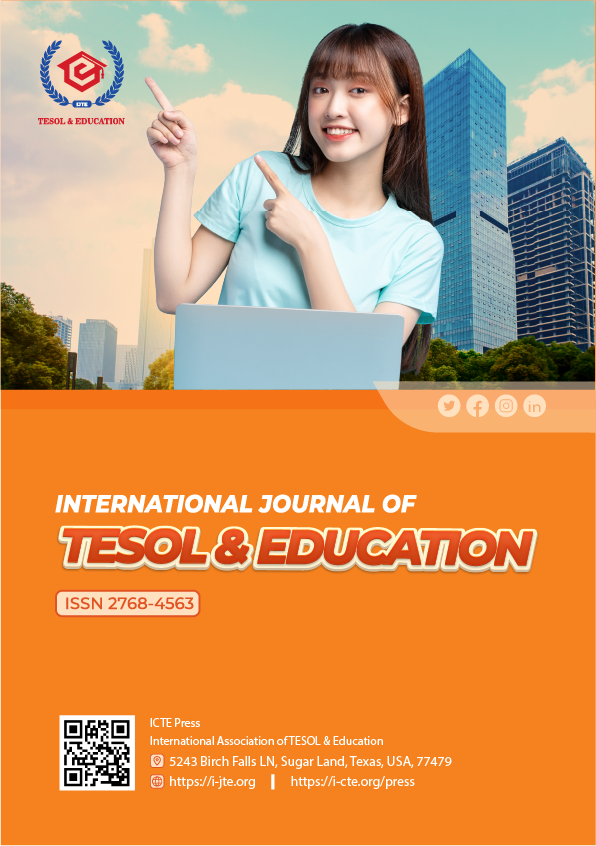Conceptual Metaphor “MEDIA AS A TRAP” in Vietnamese and English online Newspapers
DOI:
https://doi.org/10.54855/ijte.24433Keywords:
conceptual metaphor, mapping, media, trap, teaching & learningAbstract
The study explores the conceptual metaphor of "MEDIA AS A TRAP" in Vietnamese and English, aiming to understand perceptions of media in these linguistic contexts. Using the theory of conceptual metaphor in cognitive linguistics, alongside descriptive and semantic analysis methods, the research establishes and analyzes the mapping from the source domain of "TRAP" to the target domain of "MEDIA." By examining metaphorical expressions in press texts, the study uncovers underlying cognitive models, including media as trickery and media as a scam. Survey data reveals similar frequencies of metaphorical expressions in both languages, with 110 instances in Vietnamese and 90 in English, indicating a shared understanding of the metaphor. The analysis highlights significant parallels and distinctions in the conceptual metaphor "MEDIA IS A TRAP" between Vietnamese and English, underscoring its universal cognitive and linguistic significance. Both languages employ similar conceptual metaphorical expressions, yet exhibit subtle differences reflecting distinct cultural perspectives.
References
"Cambridge Dictionary", Cambridge University Press, [Online]. Available: https://dictionary.cambridge.org/vi/. [Accessed April 2, 2024]
Éva Eszter Skrobák (2023) Conceptual Metaphors as Deception Markers in Spontaneous Speech, New Horizons in English Studies. https:// DOI: 10.17951/nh.2023.22-38
Geary, J. (2012), I is an Other: The Secret Life of Metaphor and How It Shapes the Way We See the World. New York: HarperCollins Publishers.
Kövecses, Z. (2005). Metaphor in culture: Universality and variation. Cambridge University Press
Kövecses, Z. (2010). Metaphor: A Practical Introduction (2nd ed.). Oxford University Press.
Hofstede G. (2001), Culture’s Consequences: Comparing Values, Behaviors, Institutions and Organizations across Nations, Sage Publication, 2nd edition.
Lakoff, G., & Johnson, M. (1980). Metaphors we live by (2nd ed.). The University of Chicago Press.
Lakoff, G., & Johnson, M. (1987). Women, Fire and Dangerous Things: What Categories Reveal about the Mind. The University of Chicago Press.
Lakoff, G. (1993). The contemporary theory of metaphor. In A. Ortony (Ed.), Metaphor and thought (pp. 202-251). Cambridge University Press
Lý, T. T. (2015). Ngôn ngữ học tri nhận – Những nội dung quan yếu. Nxb Khoa học xã hội
Nguyễn, V. D., & Đỗ, T. T. H. (2018). Truyền thông - Lí thuyết và kĩ năng cơ bản. Nxb Thông tin & Truyền thông, 12-14.
"Oxford Learners Dictionaries" Oxford University Press, [Online]. Available: https://www.oxfordlearnersdictionaries.com. [Accessed April 2, 2024].
Pham, T.G. (2023). Conceptual metaphor “WOMEN ARE ANIMALS” in 20th century Vienamese literature. ICTE Conference Proceedings, 3, 26-40. ISSN: 2834-0000. ISBN: 979-8-9870112-2-5. DOI: https://doi.org/10.54855/ictep.2333
Phan, V. H., & Ho, T. Q. T. (2023), A cognitive Investigation into the Love-Life Relationship Expressed in Poetry, Metaphor and Symbol.38(2), 174-183. https://doi.org/10.1080/10926488.2022.2058398
Pragglejaz Group, "MIP: A Method for Identifying Metaphorically Used Words in Discourse", Metaphor and Symbol, vol. 22, no. 1, pp. 1-39, 2007.
Le, M. T., & Nguyen, T. B. (2023).Roles of Cognitive Linguistics to Second Language Acquisition. ICTE Conference Proceedings, 3, 118-126. ISSN:2834-0000. ISBN: 979-8-9870112-2-5. DOI: https://doi.org/10.54855/ictep.2339
Trần, V. C. (2007). Ngôn ngữ học tri nhận (Ghi chép và suy nghĩ). Nxb Khoa học xã hội.
Downloads
Published
Issue
Section
License
Copyright (c) 2024 Nguyen Luu Diep Anh

This work is licensed under a Creative Commons Attribution 4.0 International License.
The copyright of all articles published in the International Journal of TESOL & Education (ijte) remains with the Authors, i.e. Authors retain full ownership of their article. Permitted third-party reuse of the open access articles is defined by the applicable Creative Commons (CC) end-user license which is accepted by the Authors upon submission of their paper. All articles in the ijte are published under the CC BY-NC 4.0 license, meaning that end users can freely share an article (i.e. copy and redistribute the material in any medium or format) and adapt it (i.e. remix, transform and build upon the material) on the condition that proper attribution is given (i.e. appropriate credit, a link to the applicable license and an indication if any changes were made; all in such a way that does not suggest that the licensor endorses the user or the use) and the material is only used for non-commercial purposes.
Authors retain copyright and grant the journal the right of first publication with the work simultaneously licensed under a Creative Commons Attribution 4.0 International License that allows others to share the work with an acknowledgment of the work's authorship and initial publication in this journal.
Authors are able to enter into separate, additional contractual arrangements for the non-exclusive distribution of the journal's published version of the work (e.g., post it to an institutional repository, in a journal or publish it in a book), with an acknowledgment of its initial publication in this journal.











